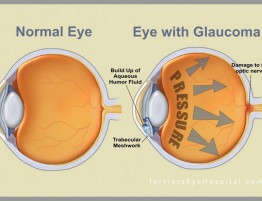The small specks, “bugs” or clouds that you may sometimes see moving in your field of vision are called floaters. They are frequently visible when looking at a plain background, such as a blank wall or blue sky and can be associated with flashes. These visual phenomena have been described for centuries; the ancient Romans called them muscae volitantes or “flying flies” since they can appear like small flies moving around in the air. Floaters are actually tiny clumps within the vitreous gel, the clear jelly-like fluid that fills the inside cavity of the eye. Although these objects appear to be in front of the eye, they are actually floating in the fluid inside the eye and cast their shadows on the retina (the light-sensing inner layer of the eye). Moving your eyes back and forth and up and down creates currents within the vitreous capable of moving the floater outside your direct line of vision.
What Causes Floaters?
The vitreous gel degenerates in middle age, often forming microscopic clumps or strands of protein within the eye. Vitreous shrinkage or condensation is called posterior vitreous detachment, and is a common cause of floaters. It also occurs frequently in nearsighted people or in those who have undergone cataract operations or YAG laser surgery. Younger patients are also occasionally seen with similar symptoms. Occasionally, floaters result from inflammation within the eye or from crystal-like deposits which form in the vitreous gel. The appearance of floaters, whether in the form of little dots, circles, lines, clouds or cobwebs, may be alarming, especially if they develop suddenly. However, they are usually nothing to be concerned about, and simply result from the normal aging process.
Are Floaters Ever Serious?
The vitreous covers the retinal surface. Occasionally the retina is torn when degenerating vitreous gel pulls away. This causes a small amount of bleeding in the eye which may appear as a group of new floaters. A torn retina can be serious if it develops into a retinal detachment. Any sudden onset of many new floaters or flashes of light should be promptly evaluated by your eye doctor. Additional symptoms, especially loss of peripheral or side vision, require repeat ophthalmic examination.
The examination will involve a careful observation of the retina and vitreous gel after your pupils have been dilated with eye drops. (Blurry vision may occur for 3-4 hours after pupil dilation, and occasionally driving home may be difficult so come to the clinic accompanied if necessary). Often it is possible to see the particular floater in the vitreous gel that is causing the problem.
Treatment of Floaters
Treatment of floaters is rarely necessary as the vast majority of patients get used to them. The brain learns to filter them out of daily visual consciousness, although some personality types find this more difficult.
An operation is available (called a vitrectomy) to suck the floaters out of the eye but it is almost never done for this reason alone.
Another more controversial laser treatment is available at a few centers across the globe.




